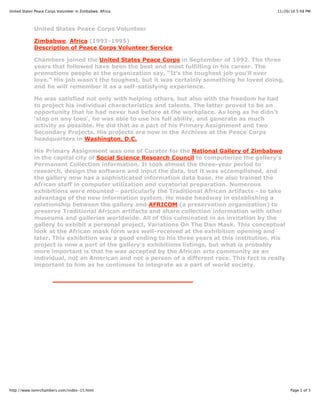United States Peace Corps Volunteer In Zimbabwe, Africa
- 1. 11/20/10 5:48 PMUnited States Peace Corps Volunteer in Zimbabwe, Africa Page 1 of 3http://www.tomrchambers.com/index-15.html United States Peace Corps Volunteer Zimbabwe, Africa (1993-1995) Description of Peace Corps Volunteer Service Chambers joined the United States Peace Corps in September of 1992. The three years that followed have been the best and most fulfilling in his career. The promotions people at the organization say, "It's the toughest job you'll ever love." His job wasn't the toughest, but it was certainly something he loved doing, and he will remember it as a self-satisfying experience. He was satisfied not only with helping others, but also with the freedom he had to project his individual characteristics and talents. The latter proved to be an opportunity that he had never had before at the workplace. As long as he didn't 'step on any toes', he was able to use his full ability, and generate as much activity as possible. He did that as a part of his Primary Assignment and two Secondary Projects. His projects are now in the Archives at the Peace Corps headquarters in Washington, D.C. His Primary Assignment was one of Curator for the National Gallery of Zimbabwe in the capital city of Social Science Research Council to computerize the gallery's Permanent Collection information. It took almost the three-year period to research, design the software and input the data, but it was accomplished, and the gallery now has a sophisticated information data base. He also trained the African staff in computer utilization and curatorial preparation. Numerous exhibitions were mounted - particularly the Traditional African artifacts - to take advantage of the new information system. He made headway in establishing a relationship between the gallery and AFRICOM (a preservation organization) to preserve Traditional African artifacts and share collection information with other museums and galleries worldwide. All of this culminated in an invitation by the gallery to exhibit a personal project, Variations On The Dan Mask. This conceptual look at the African mask form was well-received at the exhibition opening and later. This exhibition was a good ending to his three years at this institution. His project is now a part of the gallery's exhibitions listings, but what is probably more important is that he was accepted by the African arts community as an individual, not an American and not a person of a different race. This fact is really important to him as he continues to integrate as a part of world society.
- 2. 11/20/10 5:48 PMUnited States Peace Corps Volunteer in Zimbabwe, Africa Page 2 of 3http://www.tomrchambers.com/index-15.html His Secondary Project was one of arts outreach to African artists ... 'school leavers' ... who participated in three (one per year) fine arts/documentary photography workshops, The McEwen Photographic Studio, named after Frank McEwen, the first director of the National Gallery of Zimbabwe. These students showed an outstanding potential for self-expression through the medium of photography, and their works were exhibited at the National Gallery of Zimbabwe as a part of 'Moments In Time' (1993), 'Moments In Time II' (1994) and 'Moments In Time III' (1995). These exhibitions were officially opened by the U.S. Ambassador to Zimbabwe. This U.S.A. connection brought the relationship between the African community and the Peace Corps even closer. He feels good about this, and considers his contribution not only having educational value, but also public relations importance as it relates to interracial understanding. His Tertiary Project was one of grass-roots development to reach out to street children and young adults through a program called, Street Kids In Action. This educational/vocational program brought together interested parties in the African community to make an attempt to solve the 'street problem'. Concerted efforts resulted in substantial funds being raised to offer opportunities to these at-risk young people. He hopes the program is continuing to solve this problem, and he is happy that he played a role in providing the stimulus to generate this kind of activity.
- 3. 11/20/10 5:48 PMUnited States Peace Corps Volunteer in Zimbabwe, Africa Page 3 of 3http://www.tomrchambers.com/index-15.html So, those three years were not his toughest. But, he doesn't think anything else will even come close to this kind of self-satisfaction. He doesn't want to come across as a sales representative for the Peace Corps, but if you've ever been pondering this thought - you have to be a U.S. citizen, by the way - focus a little more on considering an opportunity that puts you in a situation in which you can truly be yourself.


